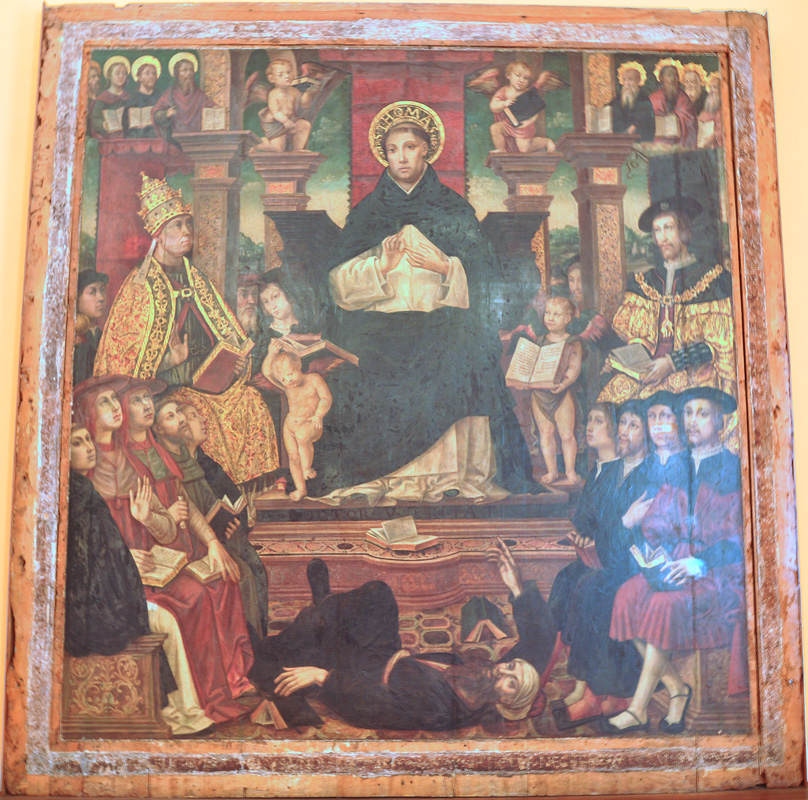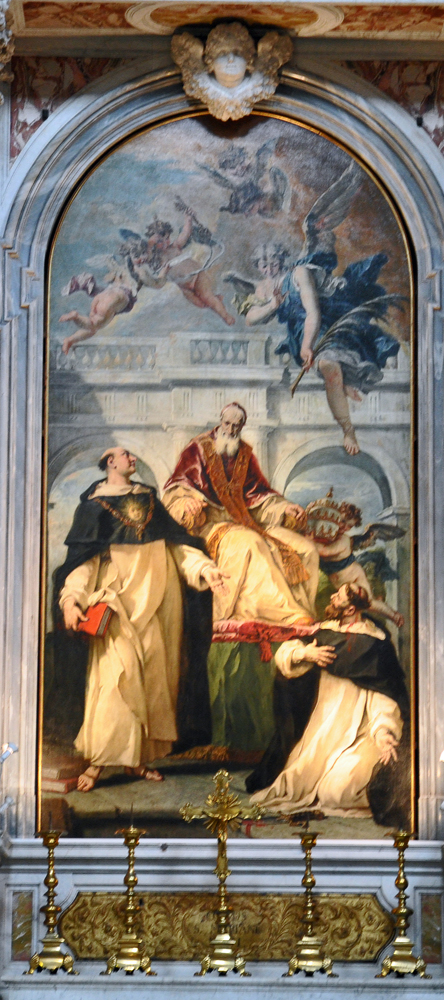According to the Golden Legend Saints Peter and Paul themselves helped Aquinas understand the scriptures (image).
Aquinas was a Dominican, so portraits normally show him in the black and white habit of that order with a distinct tonsure. Often there is a shining sun on his breast, as in the second picture at right and this example. This may be a reference to two passages in the text of the Golden Legend used by William Caxton. In the first the friars in his convent saw a star shine "in manner of a sun" for three days before his death. In the second, some years later, a "brother Albert" was praying when Aquinas appeared to him in splendid garments: "on his breast he had a great stone which of his brightness cast out many rays of clearness and illumined all the church."
Some portraits show a dove at his ear to symbolize the inspiration of the Holy Spirit (example) and, less often, a monstrance referring to his work on the doctrine of Transubstantiation (example).
Aquinas was reported to have had several experiences of ecstasy in which he was lifted two or three feet from the floor. In one of these, while he was praying at the altar Christ said to him from the crucifix, "Thou hast written well of me. What reward wouldst thou have." He answered, "Lord, nothing but you."2 In another Christ said, again from the crucifix, "Thou hast written well of the sacrament of my body."3 In images of these visions he is often accompanied by angels rather than fellow Dominicans as specified in the texts example. I have not encountered any image that pictures him floating above the floor.
Prepared in 2015 by Richard Stracke, Emeritus Professor of English, Augusta University.
HOME PAGE

Mario di Laurito, Disputation of St. Thomas, 16th century (See description page)

Sebastiano Ricci, Saints Pius V, Thomas Aquinas, and Peter Martyr, 1730-33. Aquinas is on the left with a sun on his breast. (See the description page).
ATTRIBUTES
- Sun on breast
- Dove at ear
- Dominican habit and tonsure
MORE IMAGES
- 1354-57: The Virgin Mary stands with Aquinas as he presents his writings to Christ in Orcagna's Strozzi Altarpiece.
- 15th century: A della Robbia Lunette memorializes Aquinas's defense of the mendicant orders.
- 1491: Aquinas is included with St. Lawrence and St. Paul in a stained glass window dated 1491 by Alessandro Agolanti and Domenico Ghirlandaio.
- 16th century: In a fresco in the Veneto, rays of light from the sun on Thomas's breast penetrate an image of the very church where the fresco was painted.
DATES
- Feast day: Originally March 7, changed to January 28 in 1970.
- Born 1225, died 1274
BIOGRAPHY
- Caxton's translation of the Golden Legend includes a life of Aquinas: html or pdf
- Acta Sanctorum, March vol. I, 655-747
- Carolus de Smedt et al., "Miracle de S. Thomas d'Aquin," Analecta Bollandiana, XX (1901), 208.
NOTES
1 Butler I, 510-11. Farmer, 419.
2 Acta Sanctorum, March vol. 1, 671 (William of Thoco's vita, ¶35). Also see these paragraphs in Caxton's "Life of St. Thomas Aquinas."
3 Acta Sanctorum, loc. cit., 675 (William of Thoco, ¶53).